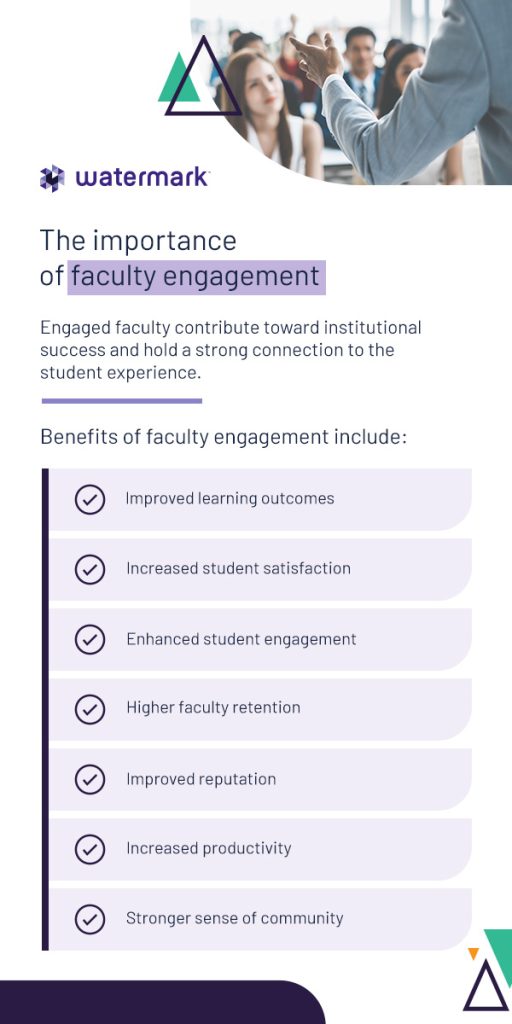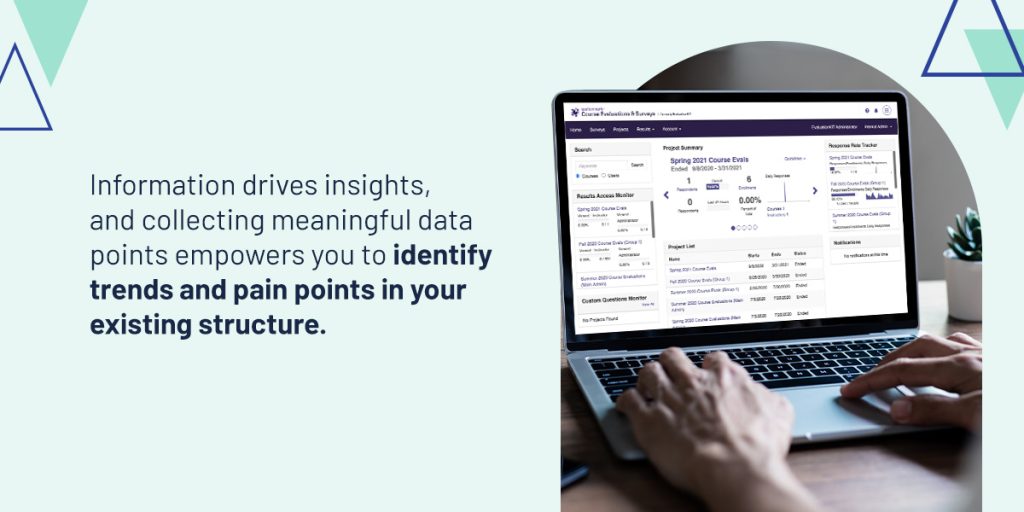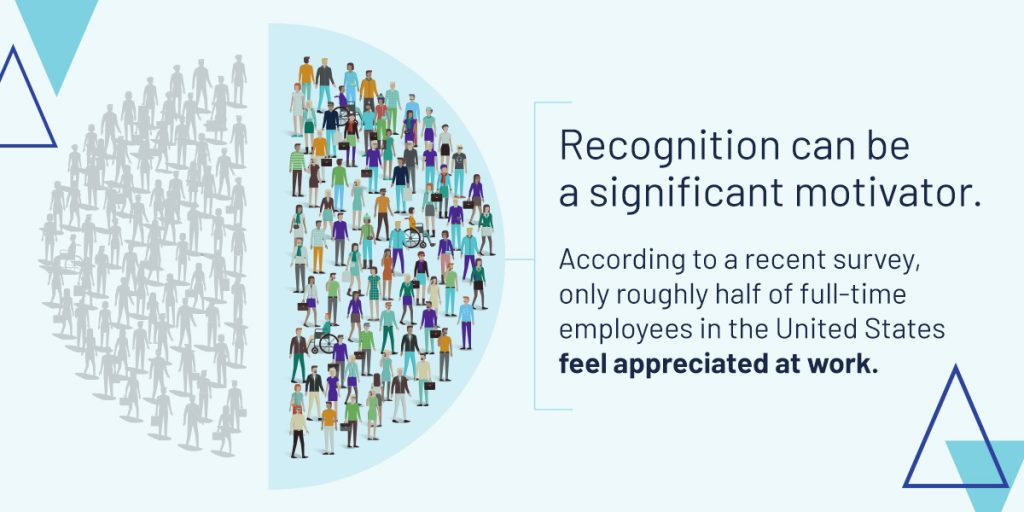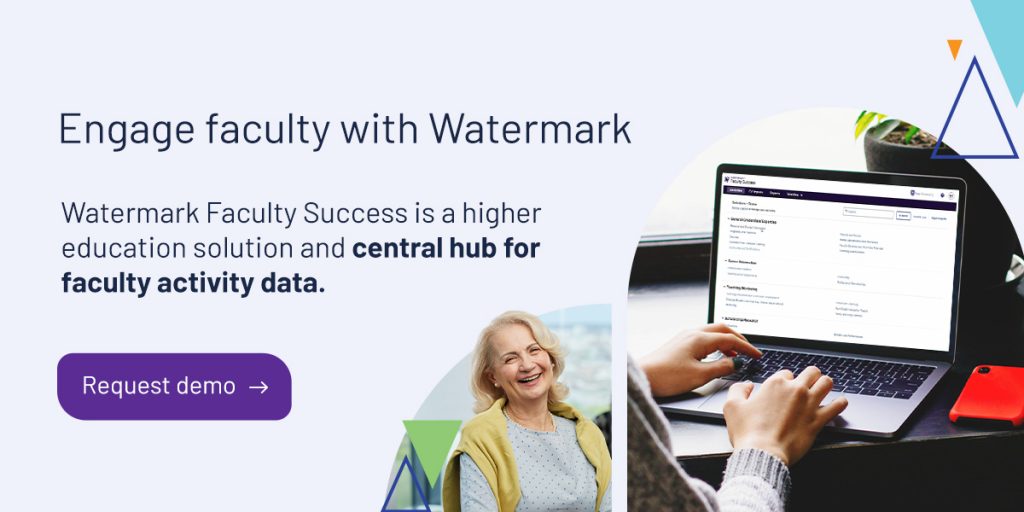




Engaged faculty members are a critical asset to higher education institutions. These environments constantly face new changes, and each year brings unique challenges for faculty to embrace. However, the start of the new school year should be an exciting time for everyone on campus, from your returning students to your new hires. Increasing engagement is crucial for your institution, not only for retaining a knowledgeable and skilled staff, but for supporting student success and aligning faculty members with your institutional goals.
Faculty engagement refers to the enthusiasm, commitment, and level of investment your faculty exhibits toward your institution and their work. While fulfilling duties is an aspect of this topic, engaging faculty spans beyond work completion. Engaged faculty contribute toward institutional success and hold a strong connection to the student experience.

Benefits of faculty engagement include:
Increasing faculty engagement involves understanding the factors that hinder engagement so you can identify institutional strengths and weaknesses. Your institution may excel in several areas but lack another crucial feature. Factors impacting engagement include:
There are many ways you can engage faculty at your institution. A combination of strategies will likely be the most effective, but you should collaborate with your team and ask for feedback on new ideas. Talk with your team to identify your best opportunity areas and check in after implementation to see if these methods bring the desired results. For inspiration, consider the following strategies:
When you assign specific projects to team members or departments, it’s crucial to express the project’s value and how each faculty member can contribute to institutional success through task completion. Emphasize the importance, goals, and projected or desired outcomes for every project to align your staff’s understanding with your vision. This strategy can also create more meaningful experiences by ensuring team members have a clear understanding of their roles and responsibilities. They can be more intentional with their actions and find more value in their tasks because they understand how their contribution will impact your institution.
You can also find ways to increase engagement for each project you assign. For example, encouraging staff with similar fields of study or project interests to work together can enhance collaboration. Enhanced collaboration can drive project outcomes and empower your team to find alternative and more meaningful ways to complete tasks.
To showcase project value and elicit team understanding, you can use student data to drive decision-making. Sharing this data with your faculty can highlight the need for change and emphasize where your strategies are working. This information can define your objectives and provide a clear focus for your team. Student data also marks a defined starting point before implementing a change and allows your team to reflect on the progress your institution makes over time.

Information drives insights, and collecting meaningful data points empowers you to identify trends and pain points in your existing structure. As you make changes and shift focus, be sure to explain why and use recent data to support your decisions. Share all findings with your team to highlight positive or negative changes, and allow faculty to see how their contributions impact outcomes and how you’re using their efforts to drive decision-making. Encourage your team to collect data in various ways, such as course evaluations and surveys alongside exams and assignment scores.
Feedback is vital for navigating challenges and creating unique solutions. Asking for feedback can engage faculty by showing each team member that you value their opinion. This process can highlight the meaning of their tasks and allow them to see how they contribute to institutional goals and success. Additionally, when making changes that impact specific teams or departments, asking for feedback is one of the best ways to ensure effectiveness and evaluate attitudes. Many of your decisions will directly impact faculty workflow and processes, so it’s crucial to speak with the people navigating these changes to ensure your strategies are making tasks easier, reducing workloads, or simplifying other aspects to drive productivity.
Furthermore, your faculty will often have a firsthand account and informed opinions regarding student-related changes. Instructors and other staff interact with your students regularly, empowering them to gather reliable information about the effectiveness of a change. These faculty members can open discussions with students to see how they perceive your efforts and where they would like to see improvements. Reliable student feedback should guide decision-making, and you should implement many opportunities for students and faculty to offer input.
Technology can have a significant impact on engagement. The right tools can eliminate repetitive tasks, lessen workloads, and enhance productivity to create a more satisfying work experience. Educational technology can engage students and faculty by increasing collaboration, creating personalized experiences, and opening opportunities for more immersive course content.
Instructors can utilize technology to improve instruction methods and implement digital tools to make content more engaging and accessible to students. Technology also empowers faculty and students to access educational resources whenever necessary. These tools allow faculty to create robust schedules that align with their peak efficiency levels, whether at home or on campus. Your team can also utilize these resources to aid in mapping curriculum, identify at-risk students, and otherwise amplify educational impact.
Faculty member collaboration supports a positive and respectful environment that facilitates trust and boosts engagement. Increasing collaboration can help align your team with institutional goals and encourage you and your staff to interact with new ideas and possible solutions. When educators work together, they can create more robust learning experiences. Faculty can discuss teaching methods, curriculum mapping strategies, and new trends that can shape the classroom experience and make tasks easier and more enjoyable.
Increased collaboration can be especially beneficial for new teachers navigating the higher education landscape for the first time. Junior-senior interactions have proved to be important for job satisfaction, and these connections can serve as networking opportunities that lead to career development.
Many higher education faculty members seek professional development opportunities while working on campus. Instructors may want to make strides in their area of study, while others may have professional goals that require specific experiences or skill sets. Expanding your training and development opportunities is an excellent way to meet these needs while enhancing engagement. A recent study highlighted that nearly 70% of workers seek employer-provided development when searching for a new job, and just under half would switch jobs if the new position offered training opportunities.
Furthermore, investing in developmental opportunities empowers you to build a faculty of experienced and skilled team members. Whether you offer a mentoring program, deliver workshops, host conferences, or have another way of encouraging development, this simple strategy can make a lasting impact on you and your staff.

Recognition can be a significant motivator. According to a recent survey, only roughly half of full-time employees in the United States feel appreciated at work. Furthermore, more than 60% of respondents report being confused about not receiving bigger projects despite meeting their existing goals. Furthermore, only 7% of those who failed to obtain a promotion received an explicit reason for the outcome.
These numbers highlight that decision-makers and leaders can amplify recognition efforts to enhance understanding and make staff feel the appreciation they deserve. Small and large actions can boost team morale. Actions like showcasing achievements within your academic community or offering incentives for reaching certain goals can help your team see that you recognize, appreciate, and encourage their efforts.
Crafting a sense of ownership can be vital for engagement. Empowering your team to take charge in the decision-making process can help them develop a strong sense of community and better align them with your goals. Diversity drives good decision-making by bringing different points of view, cultural backgrounds, and unique experiences to the discussion. This strategy also delivers several other benefits, including increasing collaboration, showing your value of team opinions, and ensuring your team is satisfied with outcomes that will directly impact them or their work.
You can engage your team with several types of decision-making — strategic, operational, and tactical. Strategic decisions have a long-term impact on your institution, and you should always be transparent about these goals and visions. Tactical decisions refer to the immediate or near-future actions your team can take to achieve your long-term goals. Operational decisions often refer to daily or high-volume tasks. Including your team in operational decisions can empower you to find solutions for streamlining tasks, repeating mundane activities, and otherwise lessening workloads for more complex and engaging opportunities.
You can cultivate a culture of shared decision-making by:
Engaging your faculty is not optional — it’s vital to your institution’s success. With Watermark, you can find the technological tools you need to connect with your team and support them in many ways. Watermark Faculty Success is a higher education solution that supports faculty development and provides a central hub for faculty activity data.
Faculty Success allows administrators and decision-makers to facilitate reviews and development, recognize faculty accomplishments, confirm credentials, and capture a holistic picture of faculty activity. This software solution supports institutional growth by enabling you to create custom reports, enhance communication, assign tasks, and more.
Start engaging your faculty with Watermark by requesting a demo of Faculty Success.






























































































































































































































































































































































































